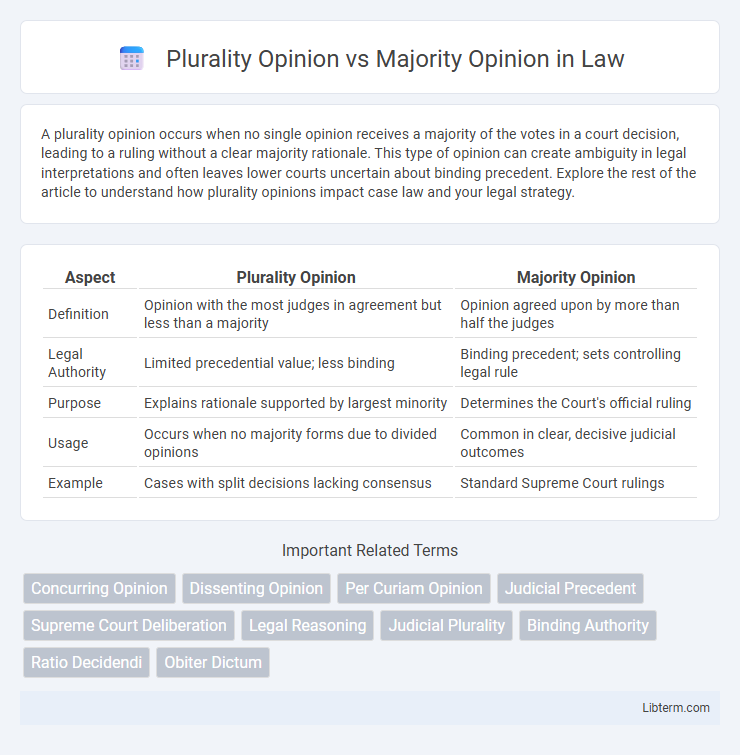A plurality opinion occurs when no single opinion receives a majority of the votes in a court decision, leading to a ruling without a clear majority rationale. This type of opinion can create ambiguity in legal interpretations and often leaves lower courts uncertain about binding precedent. Explore the rest of the article to understand how plurality opinions impact case law and your legal strategy.
Table of Comparison
| Aspect | Plurality Opinion | Majority Opinion |
|---|---|---|
| Definition | Opinion with the most judges in agreement but less than a majority | Opinion agreed upon by more than half the judges |
| Legal Authority | Limited precedential value; less binding | Binding precedent; sets controlling legal rule |
| Purpose | Explains rationale supported by largest minority | Determines the Court's official ruling |
| Usage | Occurs when no majority forms due to divided opinions | Common in clear, decisive judicial outcomes |
| Example | Cases with split decisions lacking consensus | Standard Supreme Court rulings |
Introduction to Judicial Opinions
Judicial opinions include majority and plurality opinions, which differ in their legal authority and clarity. A majority opinion reflects the view agreed upon by more than half the judges and sets binding precedent, while a plurality opinion is the opinion with the most support but less than a majority, offering limited precedential value. Understanding these distinctions is crucial for interpreting court decisions and their impact on case law.
Defining Plurality Opinion
A plurality opinion is a court decision where no single rationale gains the support of more than half of the judges, making it distinct from a majority opinion which requires over 50% agreement. This opinion reflects the judgment that received the most votes but lacks a consensus on the legal reasoning behind the ruling. Plurality opinions often occur in appellate courts, influencing case law by providing guidance without establishing binding precedent.
Defining Majority Opinion
A majority opinion reflects the view agreed upon by more than half of the judges deciding a case, establishing the binding precedent for lower courts. It provides the official reasoning behind the court's decision, guiding future legal interpretations. In contrast, a plurality opinion represents the opinion supported by the largest number of judges but lacking a majority consensus, offering limited precedential value.
Key Differences Between Plurality and Majority Opinions
A majority opinion represents the view agreed upon by more than half of the judges or justices, establishing precedent and binding authority in legal cases. In contrast, a plurality opinion reflects the stance supported by the largest number of judges but fewer than a majority, often resulting in less authoritative guidance and limited precedential value. The key difference lies in the majority opinion's definitive ruling power versus the plurality opinion's ambiguous influence due to lack of a majority consensus.
Legal Significance of Each Opinion Type
A majority opinion, representing the views of more than half the judges, establishes binding precedent that lower courts must follow, shaping future case law and legal standards. Plurality opinions occur when no single rationale gains majority support, providing persuasive but non-binding guidance that courts may consider but are not obligated to apply. The legal significance of a majority opinion lies in its authoritative weight, whereas plurality opinions influence judicial reasoning without creating precedent.
Impact on Precedent and Case Law
A majority opinion establishes binding precedent as it reflects the decision agreed upon by more than half of the judges, guiding future case law and judicial reasoning. In contrast, a plurality opinion, lacking majority support, holds less authoritative weight and does not create binding precedent, often leading to fragmented interpretations in subsequent rulings. Courts may reference plurality opinions for persuasive value, but majority opinions remain the foundational source for legal standards and precedent-setting decisions.
Examples of Landmark Cases
The Supreme Court case *Romer v. Evans* (1996) is a notable example of a plurality opinion, where no single rationale garnered a majority, resulting in a decision that lacks majority consensus but still resolves the case. In contrast, *Brown v. Board of Education* (1954) featured a majority opinion authored by Chief Justice Earl Warren, which unified the Court in declaring racial segregation in public schools unconstitutional. Plurality opinions often leave legal precedents less clear compared to majority opinions that establish binding rulings applied across future cases.
Strengths and Limitations of Plurality Opinions
Plurality opinions, representing the largest group of judges without a clear majority, offer nuanced perspectives that reflect diverse judicial reasoning but often lack the authoritative weight of majority opinions. Their strength lies in highlighting differing legal interpretations and fostering debate, yet their limitations include reduced precedential value and potential confusion in lower courts seeking clear guidance. This ambiguity can complicate the application of the ruling, impacting legal consistency and predictability.
Influence on Future Court Decisions
Plurality opinions, lacking a clear majority, hold less precedential weight than majority opinions and often lead to ambiguous legal interpretations in future court decisions. Majority opinions, supported by more than half the justices, establish binding precedent and provide a definitive legal rule for lower courts to follow. Courts tend to rely on majority opinions for guidance, while plurality opinions may influence decisions only when no majority ruling exists.
Conclusion: Understanding Judicial Consensus
A majority opinion reflects the decision agreed upon by more than half of the judges, establishing a binding precedent that guides future cases. In contrast, a plurality opinion occurs when no single view gains a majority, resulting in a fragmented ruling without clear precedent. Understanding the distinction between plurality and majority opinions is essential for interpreting judicial consensus and assessing the authoritative weight of court decisions.
Plurality Opinion Infographic

 libterm.com
libterm.com